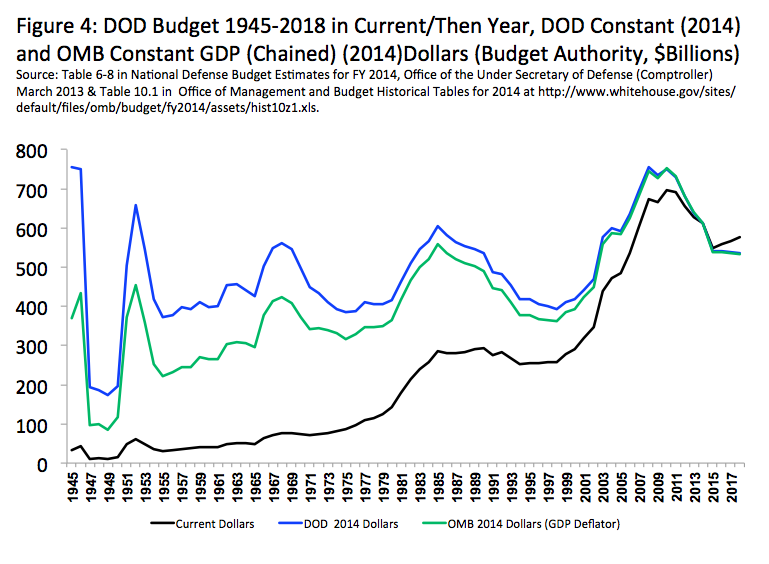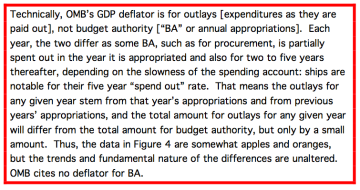The Defense Budget Is Even Larger Than You Think: part two of two
Given the warped measures that high-spending advocates and the Defense Department use to calibrate past, present and future defense spending (described here Monday), it is important to find an independent, objective yardstick to measure Pentagon spending trends accurately.
Unfortunately, there isn’t one.
If there were, this debate would be over, and I could retire.
The Bureau of Economic Analysis in the Commerce Department might be tasked with the job of finding one, but it actually plays a major role in devising the Pentagon’s self-serving measures of inflation. The Office of Management and Budget has its own deflators that are only slightly different.
Both embrace the proposition that a large portion of cost growth in Pentagon spending should be counted as inflation: the Pentagon experiences more inflation than other agencies and should get more money—the argument goes.
In the 1980s, the Congressional Military Reform Caucus argued that the Pentagon should be held to an independent but analogous measure of inflation, and identified the Producer Price Index as most appropriate. Others, especially the Defense Department, disagreed.
The differences will not be resolved here, but the question remains: what would the Pentagon’s budget history look like if it lived by the rules followed by most everyone else — especially the rest of the federal government, and the American economy?
Many employ the Gross Domestic Product (GDP) price index to calibrate the broad economic activity of the U.S. economy. The White House’s Office of Management and Budget broadly uses it. Currently it comes in the “chained” version, which attempts to weigh purchasing substitutions as prices increase. There are many controversies on the appropriateness of this measure; for example, see John William’s Shadow Government Statistics website. However, it is significant to note that the Congressional Budget Office uses such a generalized deflator in much of its defense budget analysis, especially for measuring spending over time and comparing military spending to other types of spending.
Thus, the official and most widely-used measure currently employed by OMB and others to calculate economic growth and economy-wide inflation is the “GDP (Chained) Price Index.”
OMB publishes it every year, and the data goes as far back as 1940 in its Historical Tables (Table 10-1). To answer the question, What would the Pentagon’s budget history look like if it lived by the rules followed by the rest of the federal government and the American economy?, the GDP (Chained) index is the appropriate measure.
Figure 4, below, shows the defense budget in current-year dollars, in the Pentagon’s calculation of constant 2014 (equal value) dollars, and using OMB’s GDP (Chained) Price Index to calculate separately constant 2014 dollars. Keep in mind that these very different graph-lines are all for the same annual defense budget. Most notably, there are some remarkable differences between the Defense Department’s version of its constant dollar budget history and that history as told by the measure of inflation used by the economy at large.
It is important to note that while the scale of the graph shows big differences in past decades — sometimes well over $100 billion through swaths of several years — the differences also persist right up to the present, even if the scale of the graph does not reveal the variance. For example, for 2009, the Pentagon measure of inflation
asserts that the Pentagon had $7.5 billion more in inflation than the OMB/GDP measure finds. The implication is important: the Defense Department asserts its $664 billion current-year budget had a purchasing value of $734 billion in 2014 dollars: that the $70 billion difference was due solely to inflation. The OMB/GDP measure of inflation asserts that those $664 current year dollars had a value of just $727 billion: that there was $8 billion less in any changes due to inflation.
What the Pentagon measures for itself as inflation, the OMB/GDP measure shows to be cost growth due to factors other than inflation. Potential explanations could range from more complicated than expected hardware simply costing more, increases in Defense Healthcare Program costs due to higher profit margins among companies providing Tricare for Life, or troop pay increases above the rate of inflation — all real issues.
Similarly, for the period beyond 2014, the Defense Department argues that it needs more money just to “stay even” with inflation — an extra $2.7 billion in 2018, for example It’s a deeply embedded and esoteric cost cow, and the extra money it generates over time can be immense.
If we inspect the OMB-GDP graph-line in Figure 4, we can measure that immensity and make some remarkable, heretofore unrecognized, observations about the defense budget over time:
— First, the Pentagon budget has grown over time to levels that are far higher in recent years—in “real” terms—than the spending in any other period since the end of World War II. Specifically, the $628 billion spent annually, on average, since the wars in Afghanistan and Iraq began in 2001 until 2014, compares to
— $277 billion spent on average each year in the 1950s.
— $366 billion spent on average in the 1960s.
— $342 billion in the 1970s.
— $489 billion in the 1980s.
— And $402 billion in the 1990s.
Pentagon spending since 2001 vastly exceeds that of any decade since 1950, and it is notable that the wars of the 1950s and 1960s (Korea and Vietnam) involved far larger deployments of troops and equipment than the wars since 2001.
— Second, the $612 billion President Obama is seeking for 2014 is a major increase above the average yearly amount ($354 billion) spent during the Cold War (1948-1991). The 2014 level is a $258 billion, or 72% — increase. It is notable that today’s highly-elevated spending level occurs in the absence of the existential military threat from the Soviet Union’s nuclear and conventional forces, and the additional threat of a dogmatically-communist, internationally-hostile People’s Republic of China.
In addition, Obama’s proposed 2014 spending compares to the $504 billion spent on average during the previously known high: the Reagan Administration (1981-1989). Next year’s proposed spending represents a $108 billion – 21% — increase.
If Congress goes along, Pentagon spending levels will exceed any previous high by any other president in any year in peace or in war since the death of President Roosevelt in 1945, except for President George W. Bush from 2006 to 2008.
— Third, if the additional cuts mandated by the Budget Control Act of 2011 via sequestration are allowed to take effect — thereby trimming the 2014 amount by $52 billion to $560 billion — it would return U.S. military spending to roughly 2003’s level. This amount would exceed every prior year all the way back to 1945, except the year 1985 — the peak of the Reagan years — which reached about the same level as 2014 would be with sequestration.
Finally, the shrill claims of some that reductions of the magnitudes currently being debated would cut defense spending to “dangerously low” levels or trigger a “doomsday” scenario are historically ignorant, and biased, contentions. They are intended to keep spending at near-unprecedented levels, rather than to return to norms for relative peace, once U.S. troops have left Afghanistan after a dozen years of war there.
The argument presented here does not mean that finding intelligent ways to enable U.S. armed forces to prosper at reduced spending levels will be easy or simple, but it does imply that it can be done.
Doing so would require the Pentagon and Congress get off their current fixation that the level of spending correlates directly with the level of effectiveness in our armed forces and the level of security for the nation. To achieve real reform—more effectiveness and security at lower spending levels—will require wholesale changes in the way national-security decision makers think, or failing that, it would require changes in the people who are making the decisions.
But that’s tomorrow’s issue.
Today’s bottom line is simpler: current military spending is lapping at historic highs, not lows.
Part 1: Cooked books tell tall tales
Part 2: Correcting the Pentagon’s distorted budget history




